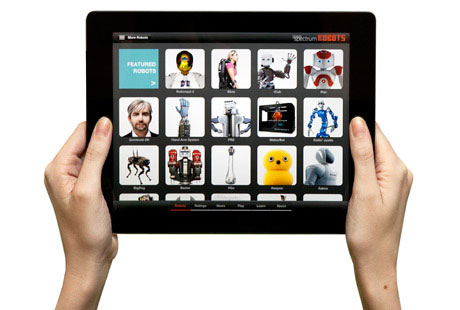| Nov 27, 2012 |
The 'Robots for iPad' app wants to be the go-to resource for robot enthusiasts
|
|
(Nanowerk News) The IEEE Spectrum Robots for iPad app debuted in the Apple App store on 27 November. With interactive 360-degree photos, descriptions, technical specs, and videos of 126 robots from 19 countries, the app aims to be the go-to resource for robot enthusiasts. A variety of robot types are featured, including humanoids, toys, and robots used in health care, research, and even space. The app, which costs US $4.99, works on all three generations of the iPad.
|
|
“This app is our love letter to robots,” says IEEE Spectrum photo editor Randi Klett, who created the app with senior associate editor Erico Guizzo. He is also editor of Automaton, the magazine’s award-winning robotics blog. “We love robots and know that a lot of other people do, too. Our goal is to help those interested in them learn more and also to introduce new people to the field,” adds Guizzo.
|
 |
|
The app was inspired by the iPad and Automaton. “After the iPad came out in 2010, we at Spectrum thought it was really interesting and wanted to develop something for it,” Guizzo says. “At that time, the blog was also picking up, so Randi and I decided to focus on something involving robots, which lend themselves to great photos, videos, and interactivity.” Guizzo and Klett worked on producing all the content and photos, with IEEE Spectrum digital editorial director Harry Goldstein serving as the project leader. The app development was funded by the IEEE marketing department and codeveloped by the IEEE Publications Technology Group and Tendigi, a New York City–based software developer.
|
|
ROBOTS GALORE
|
|
With more than 100 featured, there are lots of robots to check out. “We scoured the globe to find the most interesting,” says Guizzo. “We wanted to have a very diverse collection. When most people think of robots, they think of humanoids—robots with hands, arms, and legs that walk and can do tasks for you. But we also wanted other kinds, like toy robots, because they’re fun; flying robots, which is a huge area of robotics today; robots used in research programs; and telepresence robots, which work like remote avatars”—like the one Guizzo wrote about in his IEEE Spectrum article “When My Avatar Went to Work.”
|
|
In the toy category, you’ll learn about Keepon, a small, yellow, blob-like character that dances to music. Several health care robots are included, most notably the da Vinci surgical system, the robot used to perform many of today’s minimally invasive procedures, such as prostatectomies. Among the flying kind are the bio-inspired SmartBird robotic seagull and Harvard's RoboBee insect robots.
|
|
There are plenty of research robots, such as NASA’s Robonaut 2, which is used onboard the International Space Station to perform tasks like monitoring air flow and assisting with scientific experiments. And although it’s hard to pick favorites, Robonaut 2 comes at the top of Guizzo’s list. “It’s fascinating that there’s a humanoid robot in space,” he says. One of Klett’s favorites is also a humanoid, Geminoid DK, which bares a striking resemblance to its developer Henrik Scharfe, an associate professor at Aalborg University, in Denmark.
|
|
INTERACTIVE LEARNING
|
|
The opening page of the app has thumbnail images of all the robots. On the left side of the screen you can sort them by the year each was created, country of origin, size, or alphabetically by name.
|
|
Tapping on the image takes you to its profile page, where you can navigate through various tabs to learn about the robot’s technical specs (size, weight, components, and more), history of development, creator, type, and what it can do. There are also links to related Automaton blog posts describing the robots. On the right of the screen is a gallery of photos and videos that show the robots in action, as well as audio interviews with their developers. “We wanted the app to be interactive, so [besides the videos], many of the photos show the robot in motion,” Klett says. For example, tapping on the small humanoid robot called Nao shows a series of photos in which it moves its arms and legs to perform tai chi. You can also see a 360-degree view of some of the robots by swiping your fingers across their photos.
|
|
Another interactive feature is a ranking system. On each robot’s page, you can weigh in on just how cool—or creepy—it is. The ranking system is a nod to the “uncanny valley” hypothesis in robotics, which states that humans react with increasing revulsion as robots appear more and more humanlike.
|
|
At the bottom of each page, there’s a menu with a number of sections. The “Play” section lets you do just that. It features a game that pits two robots against each other and asks you to choose between the two in different situations. For example, one question asks which you would rather hug. The app also has a section called “Did You Know?” that features fun robot factoids. The “Learn” section provides a basic overview of robotics, including audio interviews of experts explaining how robots work. There’s also a timeline that shows the evolution of robots and a glossary that defines frequently used technical terms. And you can find the latest robotics reports from IEEE Spectrum in the “Robot News” section.
|

